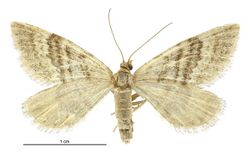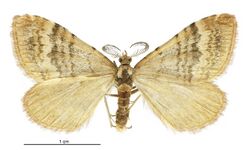Biology:Asaphodes recta
| Asaphodes recta | |
|---|---|

| |
| Female | |

| |
| Male | |
| Scientific classification | |
| Domain: | Eukaryota |
| Kingdom: | Animalia |
| Phylum: | Arthropoda |
| Class: | Insecta |
| Order: | Lepidoptera |
| Family: | Geometridae |
| Genus: | Asaphodes |
| Species: | A. recta
|
| Binomial name | |
| Asaphodes recta (Philpott, 1905)[1]
| |
| Synonyms[2] | |
| |
Asaphodes recta is a moth in the family Geometridae.[2] It is endemic to New Zealand and is found in the southern parts of the South Island. The preferred habitat of this species is open tussock grassland. The adults are on the wing in February and March. Larvae of this species have been reared on species in the genera Ranunculus and Bellis.
Taxonomy
This species was first described by Alfred Philpott in 1905 using specimens collected from Ida Valley and named Xanthorhoe recta.[3] George Hudson discussed and illustrated this species under that name in 1928.[4] In 1939 Louis Beethoven Prout placed this species in the genus Larentia.[5] This placement was not accepted by New Zealand taxonomists.[6] In 1971 J. S. Dugdale placed this species in the genus Asaphodes.[7] In 1988 Dugdale confirmed this placement.[2] The male holotype specimen, collected at Ida Valley in Otago, is held at the New Zealand Arthropod Collection.[2]
Description
Philpott described this species as:
♂, 31 mm. Head, thorax, and abdomen ochreous. Forewings moderate, greyish-ochreous, irregularly suffused with reddish especially towards costa, markings brownish ; first line before 1⁄3, curved, anteriorly edged with grey ; median bandformed of three or four thin lines with narrow spaces of ground-colour between ; the first of these is almost straight and rather darker than the others ; the posterior edge of the last one is irregular with two strong projections below middle ; this is followed by a narrow band of pale-greyish, almost white in some examples ; a broad band of brown from 4⁄5 of costa to tornus, posteriorly waved and followed by a waved pale line ; cilia long, brownish-pink. Hind wings long, narrow, pale-yellow ; a terminal series of indistinct linear brownish spots ; cilia pink.[3]
Distribution
This species is endemic to New Zealand.[1] Along with the type locality, specimens had also been collected near Dunedin and Invercargill.[3][4]
Habitat
The preferred habitat of this species is open tussock grassland in Otago and Southland.[4][3]
Behaviour
The adults of this species are on the wing in February and March.[4]
Hosts
Larvae of this species have been reared on species in the genera Ranunculus and Bellis.[8]
References
- ↑ 1.0 1.1 "Asaphodes recta (Philpott, 1905)". https://www.nzor.org.nz/names/f87c425c-efd5-43cb-9c3a-0297ca56b470.
- ↑ 2.0 2.1 2.2 2.3 , pp. 174, Wikidata Q45083134
- ↑ 3.0 3.1 3.2 3.3 Philpott, Alfred (1905). "On some new species of Lepidoptera" (in en). Transactions and Proceedings of the New Zealand Institute 37: 328–333. https://biodiversitylibrary.org/page/3743097.
- ↑ 4.0 4.1 4.2 4.3 Hudson, G. V. (1928). The Butterflies and Moths of New Zealand. Wellington: Ferguson & Osborn Ltd.. pp. 120. OCLC 25449322. http://www.bugz.org.nz/WebForms/ResultDetails.aspx?CurrentDoc=C7E94865-492F-45DA-9777-CC8E1E8B1438&back=true&NewDoc=true&searchType=1&SearchString=G.V.+Hudson.
- ↑ Prout, L. B. (1939). "Geometridae: Fauna Indo-Australica". The Macrolepidoptera of the World 12: 264. https://www.biodiversitylibrary.org/page/12779936.
- ↑ , Wikidata Q54670161
- ↑ , Wikidata Q64006453
- ↑ , Wikidata Q109608608
Wikidata ☰ Q41829483 entry
 |


